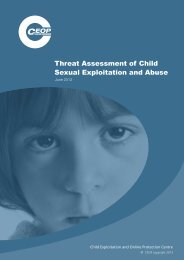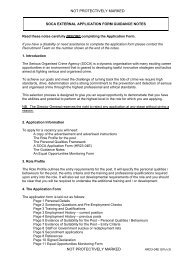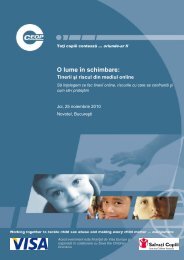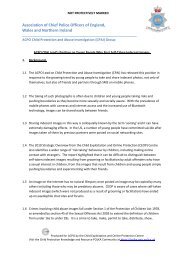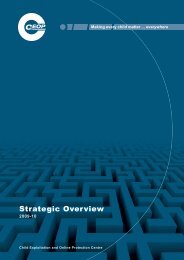The trafficking of women and children from Vietnam - CEOP
The trafficking of women and children from Vietnam - CEOP
The trafficking of women and children from Vietnam - CEOP
Create successful ePaper yourself
Turn your PDF publications into a flip-book with our unique Google optimized e-Paper software.
NOT PROTECTIVELY MARKED<br />
were illiterate (extremely high for <strong>Vietnam</strong>); 299 (43.3%) had a primary-level education only;<br />
<strong>and</strong> 250 (36.2%) had a secondary-level education. 19 Culture <strong>and</strong> tradition dictate that<br />
<strong>children</strong>, especially girls aged 16 <strong>and</strong> 17, feel that they need to financially support their<br />
families through work. Equally, family members, especially parents, will expect their<br />
<strong>children</strong> to support them. This is more pronounced in poorer rural areas creating an<br />
environment favourable for recruiting <strong>trafficking</strong> victims. 20<br />
<strong>The</strong> experience <strong>of</strong> NGOs such as AAT <strong>and</strong> Pacific Links Foundation is that many girls who are<br />
trafficked left education at 14 seeking work, <strong>of</strong>ten to support their families. Additionally,<br />
many <strong>of</strong> these girls had behavioural issues, were unhappy at home <strong>and</strong> were therefore<br />
vulnerable to being trafficked in the first place. In a drive to counter this, the government<br />
<strong>and</strong> NGOs, including Saigon Children’s Charity, launched an initiative paying girls <strong>from</strong> poor<br />
families, or with behavioural problems, to attend school beyond the age <strong>of</strong> 14. However,<br />
according to Save the Children, money was <strong>of</strong>ten given directly to the parents rather than<br />
through the schools, preventing the conditionality <strong>of</strong> finances in return for attendance.<br />
For these reasons <strong>and</strong> others, <strong>trafficking</strong> networks tend to recruit extensively in rural areas.<br />
Traffickers may be connected to friends <strong>and</strong> family members <strong>of</strong> those they seek to recruit,<br />
<strong>and</strong> on occasion may actually be connected directly to the victim 21 or the locality. This helps<br />
to win the trust <strong>of</strong> victims <strong>and</strong> their family. For example in the province <strong>of</strong> Lao Cai (located<br />
in north <strong>Vietnam</strong> on the border with China) the Department <strong>of</strong> Social Evils Prevention <strong>of</strong> the<br />
Provincial Department <strong>of</strong> Labour, Invalids <strong>and</strong> Social Affairs (DOLISA) has identified <strong>and</strong><br />
stopped a significant percentage (estimated at 40%) <strong>of</strong> potential victims <strong>from</strong> being<br />
trafficked by their boyfriends. DOLISA’s pr<strong>of</strong>ile indicates the boyfriends may <strong>of</strong>ten have<br />
drug dependency problems <strong>and</strong>/or have substantial gambling debts. Thus they attempt to<br />
generate funds for these addictions by exploiting their partners. This phenomenon has also<br />
been observed by AAT in south <strong>Vietnam</strong> with <strong>children</strong> being exploited internally or<br />
19<br />
Report on Assessing the Return <strong>and</strong> Reintegration <strong>of</strong> Victims <strong>of</strong> Cross-Border Trafficking. Save the Children,<br />
Hanoi, <strong>Vietnam</strong>. February 2008<br />
20<br />
Summary Report. A Rapid Assessment <strong>of</strong> the Situation <strong>of</strong> Migrant Children in <strong>Vietnam</strong>. Save the Children.<br />
June 2006<br />
21<br />
MOLISA stated that girls have been sold by their boyfriends, some <strong>of</strong> which they were in long term<br />
relationships with<br />
Page 14 <strong>of</strong> 31



